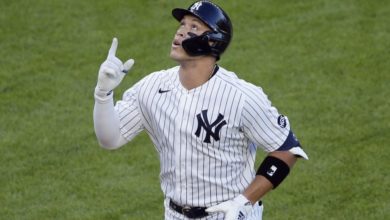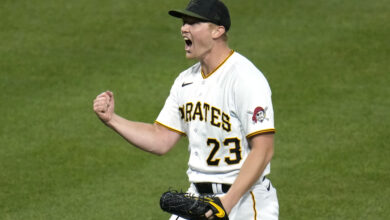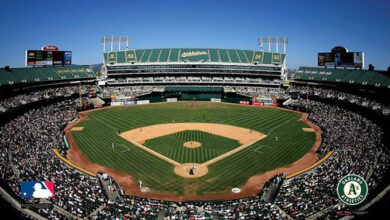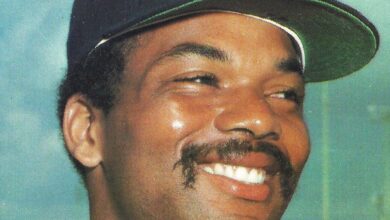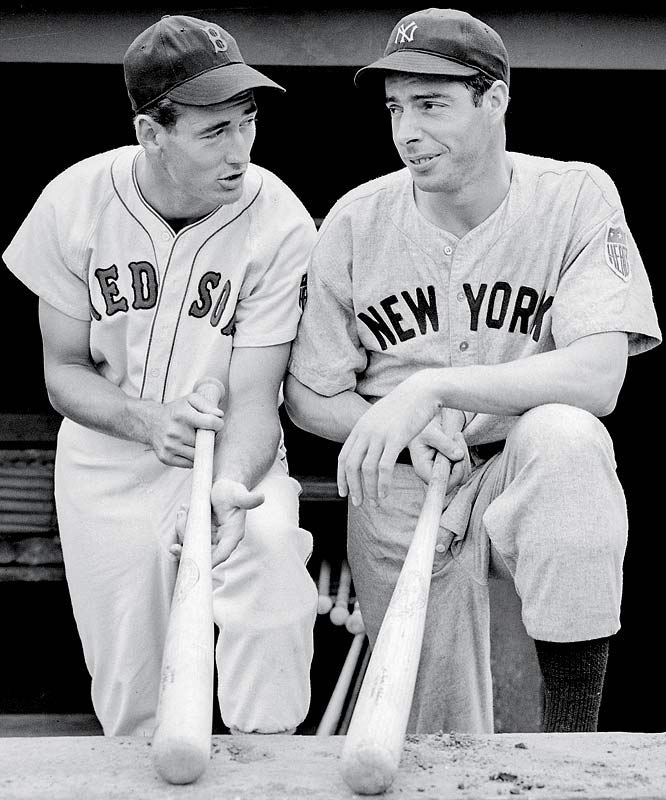
Ted Williams hitting three home runs in one game. Stan Musial‘s farewell tour. Ralph Kiner blasting a long home run. Billy O’Dell shooting pigeons in an empty ballpark. Lifelong baseball fan Tom Findlan has seen a lot in his 80 years.
A pigeon-shooting pitcher
Tom was in dental school in Pittsburgh’s Oakland section in the late 1960s. One sunny, 70-degree weekday afternoon, he walked along South Bouquet Street toward Forbes Field, “a place that I loved,” he told me. He spotted a green Chrysler, which he knew was the car Roberto Clemente drove. He walked toward it, hoping for a chance meeting with the Pittsburgh Pirates’ superstar. Clemente wasn’t there but the corrugated entrance doors into the old ballpark were up. Tom entered, helping himself to a seat opposite first base. Nobody else was in the entire ballpark but a groundskeeper, watering the dirt base path out by shortstop.
“I must have fallen asleep,” said Tom. “I wasn’t asleep very long. I’d say maybe ten minutes or so but I woke up and I looked down and the groundskeeper was gone. I was the only guy in the whole place. As I was sitting there, I looked down out toward the right field bullpen and somebody came out of the door there and walked out to right field, about where Clemente would play.
“All of a sudden I saw him point this thing up in the air and blam! blam! Here was this guy shooting pigeons! He had a shotgun and he was shooting pigeons out of the rafters. I thought, this is unbelievable! So he did that for a few minutes. Then, I guess it was the groundskeeper who came out and I walked down to the field and said, ‘Who is that out there?’ and he said, ‘That’s Digger O’Dell!'”
O’Dell pitched in the Major Leagues from 1954-68 with four teams, the last two years with the Pirates. Nicknamed “Digger” after the undertaker in the popular 1930s radio program The Life of Riley, his career record was 105-100 and a 3.29 ERA.
A real baseball fan
Tom is a retired dentist from Franklin, a town about 85 miles north of Pittsburgh. We first met on October 13, 1994 at the annual celebration of the anniversary of game seven of the 1960 World Series at what remains of the Forbes Field outfield wall. Having turned 80 last November, Tom doesn’t make the trip into Pittsburgh any longer. We speak on the phone a few times a year. He’s always got so many good baseball stories. Finally, I decided they needed to be published somewhere. We spoke for over 90 minutes on the evening of April 28. When I called him at the appointed time, not surprisingly he had been out watching a youth baseball game in which his grand nephew participated, despite the freezing temperatures that hit western Pennsylvania on that day.
Williams hits three homers
The conversation began with the time young Tom saw Williams hit three home runs in a game at cavernous Cleveland Stadium on June 13, 1957. At the time, Tom was a newspaper boy. The Franklin newspapers decided to take the paper boys to a game in Cleveland where the Indians would take on Williams and the Boston Red Sox.
The paper boys had seats near the Red Sox dugout on the outfield side. That day, Williams became the first American League batter to hit three home runs in a game twice in the same season. It was the third and final time Williams ever hit three homers in a game.
Williams hit the first two homers off Early Wynn and the third off Bob Lemon, two Hall of Fame right-handers. Tom remembered lefty Hank Aguirre striking Williams out. After the game, Williams expressed surprise that he was the first in the league to accomplish the feat. In the home clubhouse, Lemon was gracious in defeat, while Wynn groused that the umpire squeezed the plate with Williams at bat. But the lasting memory that stayed with Tom occurred before the game.
Up, up and away
“Williams was done with batting practice,” said Tom, “and came walking over to go into the dugout and this was literally 15 feet in front of us. As we was preparing to go down the steps into the dugout, he took the bat and put it between his legs and with both hands, he threw it high in the air. It was spinning like a baton and it went pretty high up in the air. He took two steps and was in the dugout and gone and the bat came down and almost hit Jimmy Piersall. It almost clobbered him. He was really upset, really furious about it. Looking back, I thought, that wasn’t very considerate. He could have really hurt somebody by doing that.”
Kiner the lone bright spot
The subject turned to the Brooklyn Dodgers. On July 19, 1952, the little league in which Tom played took all of its players by bus to see the Pirates and the Dodgers in Forbes Field.
Tom remembered Jackie Robinson at the plate “with his hands really high” and vividly recalled Roy Campanella‘s walk to the dugout after the game’s final out. I was curious to know how the Pittsburgh fans reacted to the integration of major league baseball. Tom told me, “I don’t remember any racial problems, that I was aware of, when Robinson and Campanella were playing in Pittsburgh.”
The 1952 Pirates are thought by many to have been the worst team in the history of baseball. Conversely, the Dodgers of 1952 won the league pennant. I believe them to have been the best team in the history of the National League. (More on that another day.) Predictably, the Dodgers won decisively behind Carl Erskine‘s complete game and Pee Wee Reese‘s grand slam.
“We were losing 9-0 to the Dodgers,” related Tom. “We were on the third base side, up a little bit, not down real close to the field and Ralph Kiner was on deck. He was swinging his bat like a mad man, loosening up. He was really going at it. He got up to the plate and he hit a ball like Dick Stuart hit one, over the scoreboard, in the ninth inning. Then the people left the stadium. They always left after Kiner hit. We lost 9-1″
From 1950-57, the Pirates never finished higher than seventh in the league. Tom remembered when the Milwaukee Braves’ Warren Spahn pitched against those Pirates teams, “I never saw so many infield pop-ups in my life.”
Musial’s farewell tour
Tom also spoke of attending a doubleheader at Forbes Field between the Pirates and the St. Louis Cardinals on July 15, 1962, when Musial was on a farewell tour of sorts. Actually, Musial played one more year, but he had been dropping hints about possibly retiring after the 1962 season.
As the second game began, according to Tom, “I was on the third base side. I never had money for real great seats. I was [in the] back. People were filtering down into their seats and vendors were selling their ice cream and beer. [With two outs in the top of the first], Musial stepped up to the plate. Joe, the whole stadium stopped. Everything stopped. People stood in the aisles. The vendors stopped. Everybody’s watching. As I recall, he took one pitch and singled the next pitch into right field, a line drive into right field. He ran to first base. Suddenly the people started going to their seats, the vendors started selling things and everything resumed. But when he was up to bat, the world stopped. It was so cool! Everything stopped!”
The 1960 World Series
Every Pirate fan who was alive at the time has a story about the 1960 World Series. Tom was a sophomore at St. Vincent College, a small Catholic college about 40 miles southeast of Pittsburgh. He was watching game seven on TV in the “day-hop lounge” on the basement floor of Alfred Hall. When Bill Mazeroski hit his legendary home run to win the Series for the Pirates, everybody in the lounge started screaming and throwing the couch pillows in the air. Tom’s buddies started talking about heading into Pittsburgh where the biggest celebration the city had ever seen would take place. The problem? Tom couldn’t go because he had a physics test the next morning.
The physics test that never was
“We had this teacher, Father Roland Heid,” said Tom, “who was measuring the radioactivity in the rainfall due to the Russian nuclear test in the atmosphere at the time. He was big into math and I was not good at higher math.” Some students approached Father Roland during his nightly after-dinner walk around the campus and asked if he would cancel the test because some of the boys wanted to go into Pittsburgh.
As Tom tells it, “His response was ‘You tell the boys to go in and have a good time.’ They said ‘You mean you’ll cancel the test?’ He says, ‘No. If they don’t know the material now they never will.'” Of course, Tom and the other physics students stayed behind to study.
The next day, “Father Roland walks into the room and we’re all sitting there ready to take the test and he says, ‘Boys, last night a few of you approached me and asked me if I would cancel the test. At the time I declined. However, after giving it due thought, we will have the test next week.’ He turned around and walked out of the room. None of us could believe what we heard. We realized that we missed the greatest party that Pittsburgh ever had because of the physics test that never was.”
The letter
A few years after the pigeon-shooting incident, Tom wrote to O’Dell and asked about it. Said Tom, “I never heard anything. Joe, I wanna say it was a couple years. I got [an envelope] one day from O’Dell and I opened it up and there was his baseball card. There was no letter, nothing at all to respond to my inquiry. So I concluded from that fact, that Billy O’Dell was not a man of letters.”


